
In the Dakota language, “earth lodge” is maka tipi. But it’s also a verb meaning “they live.”
Lisa Johnson
Jim Rock’s great-great grandparents made the thousand-mile trek into exile from Minnesota to Saskatchewan on foot in the 1860s. His Dakota father, Tabdoka Sapa Itokab Nażiŋ Šni, was one of the last five first-language speakers of Dakota in Minnesota before his death in 2010. So even though Jim has spent his life teaching chemistry, physics and astronomy, these days he’s bringing his skills to a project involving what he calls traditional Dakota “star-chitecture.”
In 1863, an act of Congress created the federal Dakota Removal Act, banishing Dakota people in Minnesota from the state and authorizing the sale of their reservation lands to settlers. Over three thousand people were forcibly relocated to other states and Canada. Minnesota even followed up with a bounty of $25-$200 on anyone that can prove they killed a Dakota.
160 years later, three traditional Dakota earth lodges are nestled on a bluff overlooking the Minnesota River valley. Zaní Otúŋwe (“Village of Wellness”) is located on a 21-acre piece of land outside of Granite Falls, part of a vision by its founders of land restored to health, people restored to their homeland, and a community able to live as sustainably and off-grid as possible.
The mission of the non-profit Makoċe Ikikċupi (“land recovery”) is reparative justice: land and cultural restoration, reunification of a dispossessed people with their homeland, and creating it all with an eye toward food security and sustainability. With a governing council made up of experts in these fields and more, the eventual goal is to purchase ten parcels of Dakota homeland, (paid for by voluntary “settler donations” in line with the reparative justice mission), so Dakota people can come home. Currently, Dakota people live on about one-hundredth of one percent of their original land base and only 10% live here in Mni Sota Makoċe (“Land Where the Waters Reflect the Sky”).
Our dream is to acquire lands within our ancestral territory where Dakota people may establish new communities based on sustainability and adherence to our ancient ways of being. We hope to resume traditional practices of wild-ricing, sugar-bushing, hunting, and foraging in some places, while also growing our traditional gardens, reconstituting our traditional forms of governance, practicing our spirituality, educating our children, and throughout all these activities, speaking our language. Makoċe Ikiċupi, from their website
A road bump – and unexpected allies
After ten years of fundraising and research into building earth lodges (since they hadn’t been constructed in Minnesota for 300 years), the first parcel of land was purchased, and work began on Zaní Otúŋwe in August of 2019. A month later, a stop-work order arrived from the City of Granite Falls. Not surprisingly, ancient I/indigenous building practices were not in compliance with MN State Building and Fire Codes.
Makoċe Ikiċupi set a meeting with the City of Granite Falls, armed with pipes, a spiritual leader and the executive director, Dr. Waziyatawiŋ. Not only did city leaders support the building of the earth lodges, they agreed to have their attorneys draft the legislation and help get it passed by the Minnesota legislature.
The COVID-19 pandemic slowed the process, but Makoċe Ikiċupi was surprised and pleased to find allies on both sides of the aisle and in June of 2021, the waiver to not follow the building codes was signed into law.
Star-chitecture
Jim Rock is a Dakota and a scientist, so he’s equally immersed in efforts to “I/indigenize” his fields through work with a variety of organizations like the University of Minnesota, NASA, and the Science Museum of Minnesota.
He’s fascinated by the way science, engineering, and I/indigenous cosmology (hence, “star-chitecture) come together in the building of the earth lodges. Four vertical poles are placed first, representing the four seasons. Then four horizontal beams are placed to join them, representing the four days (solstices and equinoxes) that separate the seasons.

“First Mother Lodge” with Dakota historian, Dr. Waziyatawin and founding governing council member, Dr. Roxanne Gould. Photo by Jim Rock
The thirteen poles placed around the outside of the lodge represent the thirteen moons of the Dakota calendar , and the 52 roof beams correspond to a system of 52 weeks in a year. The turtle’s domed shell also shows thirteen parts for these moons, a significant observation as part of life on what I/indigenous people here called Turtle Island.
 51 More roof poles to go! Photo credit: Jim Rock
51 More roof poles to go! Photo credit: Jim Rock

“We lean together in a strong way to support each other” Photo credit Jim Rock
“Chop wood, carry water”
Zen Buddhism emphasizes the need to “chop wood, carry water” at all stages of any pursuit. For the people who live in these off-grid earth lodges, it’s a literal necessity, although an earth lodge in Sisseton, SD survived the 2014 polar vortex’s -60° temperatures at a relatively balmy 60° above.
As work resumes on the planned seven lodges and five greenhouses for Zaní Otúŋwe and the newest community, Hohwożu Otúŋwe (“those who plant near water”), this spring, the governing council is also doing the everyday hard work of raising money and awareness. By 2025, Makoċe Ikiċupi hopes to have seven earth lodges and a functioning permaculture site built, with at least six Oċeti Ŝakowiŋ Oyate (the tribes of the Seven Council Fires) families living at Zaní Otúŋwe. And by 2050, 187 years later after Dakota people were exiled from their homeland, organizers hope to welcome more families back home with at least ten more sites. There will be land for hunting, fishing, foraging, sugar-bushing and harvesting wild rice, but perhaps most importantly, communities of maka tipis can once again signal here is where “they live.”
(For more information about Makoċe Ikiċupi, check out their website at https://makoceikikcupi.com/. You can also read more about the project via the Supporting Dakota Land Justice zine, written and designed by Gabriela Ines Diaz (Chamoru/Pohnpeian) here: https://thecirclenews.org/news/zine-inspired-by-global-indigenous-sovereignty-movements/)
Lisa Johnson is an Upstream Storyteller from Alexandria, Minnesota